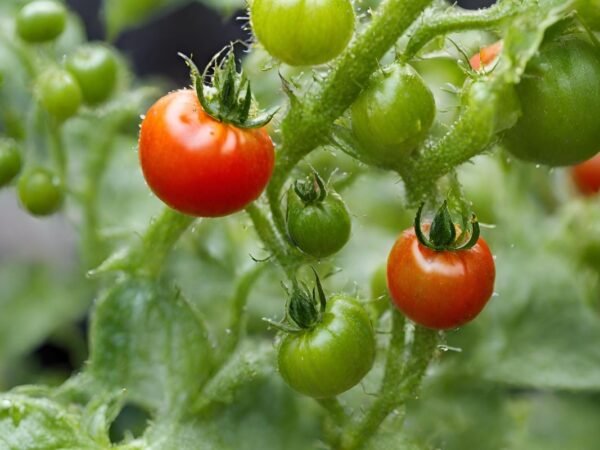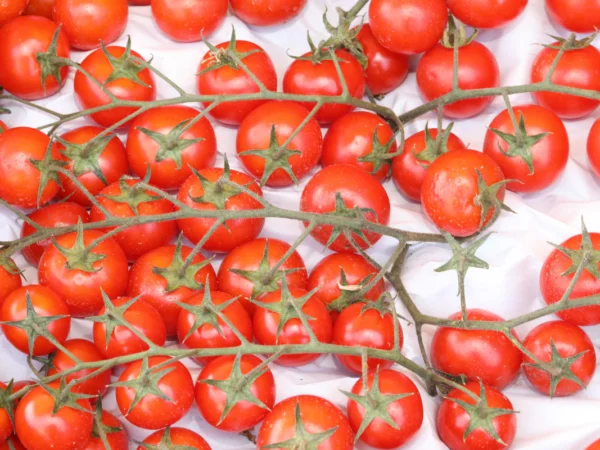Freeze-drying tomatoes is a game-changer for preserving this favorite garden fruit. Whether you love to cook, are into homesteading, or simply want to savor the burst of summer in every season, freeze-dried tomatoes are the way to go. /// The process not only locks in the flavor and nutrients but also extends their shelf life by years compared to traditional methods. ///
The history of freeze-drying dates back a lot of years and has been used extensively for preserving food and even plants. /// In this guide, we'll coach you through the simple steps to freeze dry tomatoes at home using just a tray and your freezer.
Understanding Freeze-Drying Tomatoes
Freeze-drying tomatoes involves several key steps that are crucial in preserving their flavor and texture. Firstly, the tomatoes are washed and sliced into uniform pieces to ensure even drying. This step is essential as it allows for consistent moisture removal during the subsequent freeze-drying process. Once sliced, the tomatoes are then placed onto trays in a single layer to facilitate efficient freezing.
The next stage involves placing the trays of tomatoes into a freeze dryer, where they undergo sublimation - a process where frozen water directly transitions into vapor without passing through the liquid state. This phase is critical because it removes moisture from the tomatoes while maintaining their structure and nutritional content. The entire freeze-drying process typically takes around 24-36 hours, depending on factors such as tomato thickness and moisture content.
Preparing Tomatoes for Freeze-Drying
Cleaning and Slicing
Before freeze-drying tomatoes, it's crucial to clean them thoroughly. Start by washing the tomatoes under running water to remove any dirt or debris. After cleaning, pat them dry with a clean cloth or paper towel.
Aim for uniformity in thickness. This ensures that all tomato slices will freeze-dry at the same rate, resulting in consistent texture and flavor.
For instance, if some slices are thicker than others, they may not fully dehydrate during the process. As a result, you'll end up with a mix of soft and crisp pieces instead of uniformly freeze-dried tomatoes.
Pre-Freeze Tips
Pre-freezing your tomatoes before placing them in the freeze dryer can significantly enhance the overall outcome. By pre-freezing the tomatoes on a baking sheet lined with parchment paper or silicone mat until firm, you're helping to preserve their shape and texture during freeze-drying.
Without pre-freezing, there's a risk of ending up with mushy or partially dried tomatoes due to excess moisture content. The pre-freeze step helps lock in the structure of each slice before subjecting them to the freeze-drying process.
In addition to improving texture and appearance, pre-freezing also reduces drying time during the actual freeze-drying process. This means you'll achieve perfectly preserved tomatoes more efficiently without compromising quality.
The Freeze-Drying Procedure
When loading tomatoes into the freeze dryer trays or shelves, it's crucial to ensure proper spacing and arrangement. This prevents the tomatoes from sticking together during the process. Careful handling is essential to avoid damaging the tomatoes while loading.
For example, when loading cherry tomatoes, it's best to place them with some space between each tomato on the tray. This ensures that they don't touch each other during freeze-drying, leading to a more uniform outcome.
Moreover, when dealing with larger varieties like beefsteak or roma tomatoes, arranging them evenly across the tray helps facilitate consistent airflow around each piece.
Storing Freeze-Dried Tomatoes
There are several choices to consider. One popular option is using airtight plastic bags. These bags are convenient and lightweight, making them easy to store in the pantry or cupboard. However, they may not be as durable as other packaging materials and can be punctured or torn.
Another alternative is vacuum-sealed pouches. These pouches remove air from the package before sealing, helping to preserve the quality of the tomatoes for a longer period. They are excellent at preventing moisture and oxygen from reaching the tomatoes, thus extending their shelf life significantly.
It's also essential to consider using glass jars with airtight lids when storing freeze-dried tomatoes. Glass jars provide excellent protection against moisture and pests while allowing you to see the contents inside without opening them frequently.
Pros:
-
Airtight plastic bags are lightweight and convenient.
-
Vacuum-sealed pouches help preserve quality by removing air.
-
Glass jars offer superior protection against moisture and pests.
Cons:
-
Airtight plastic bags may not be as durable as other options.
-
Vacuum-sealed pouches might require special equipment for sealing.
-
Glass jars can be heavy and prone to breakage if mishandled.
Best practices for sealing packaged tomatoes include ensuring that all containers or bags are completely sealed with no openings where air or moisture could enter. Labeling each package with the date of freezing will help you keep track of freshness during storage.
Creating ideal storage conditions is crucial in maintaining the quality of freeze-dried tomatoes over time. The optimal environment should have low humidity levels since any exposure to moisture can compromise the texture and flavor of the dried produce.
It's important to store freeze-dried tomatoes away from direct sunlight or heat sources such as stoves or ovens because these elements can accelerate spoilage due to increased temperatures.
Factors that impact shelf life during storage include exposure to oxygen, light, temperature fluctuations, and improper packaging techniques. Oxygen absorbers placed within packages can help mitigate this issue by removing excess oxygen that could lead to degradation over time.
Proper storage containers play a vital role in preserving freeze-dried foods effectively; therefore, selecting containers made from food-grade materials like high-quality plastics or glass is recommended for long-term storage purposes.
Rehydrating Freeze-Dried Tomatoes
Water Ratio
When rehydrating freeze-dried tomatoes, the water ratio plays a crucial role in achieving optimal results. It's important to ensure that the tomatoes have an ideal water content level before freeze-drying them. This ensures that they rehydrate properly when needed. To achieve this, make sure the tomatoes are not too dry or too moist before placing them in the freezer.
Achieving an optimal water content level involves carefully monitoring the texture and juiciness of the tomatoes before freeze-drying them. The goal is to remove enough moisture for preservation while retaining sufficient water content for successful rehydration later on. When preparing the tomatoes for freeze-drying, it's essential to follow guidelines to maintain their natural moisture and prevent excessive dryness.
The water ratio significantly affects how quickly and effectively freeze-dried tomatoes can be rehydrated. If there's insufficient water content during freeze-drying, it may lead to longer rehydration times and less satisfactory results.
Time for Rehydration
The rehydration time varies depending on how you plan to use your freeze-dried tomatoes. For instance, if you intend to incorporate them into soups or stews, they will require more time to fully regain their original texture and flavor compared to using them in salads or as toppings.
To achieve a desired texture through rehydration, consider soaking the freeze-dried tomatoes in cold or hot water based on your preference. Cold-water soaking generally takes longer but helps preserve more of the tomato's original shape and firmness compared to hot-water soaking which speeds up the process but might result in softer textures.
Factors such as temperature and humidity levels can influence rehydration time as well. In drier environments with lower humidity levels, it might take slightly longer for freeze-dried tomatoes to fully absorb moisture during rehydration compared to more humid conditions where absorption occurs at a faster rate.
Using Freeze-Dried Tomatoes in Recipes
Freeze-dried tomatoes are incredibly versatile and can be used in a wide variety of culinary applications. Whether you're making pasta sauce, soups, or salads, these preserved tomatoes add a burst of flavor to any dish. For instance, when making pasta sauce, simply rehydrate the freeze-dried tomatoes by soaking them in warm water for a few minutes before adding them to your sauce. The result is an intense tomato flavor that enhances the overall taste of the dish.
In addition to pasta sauces, freeze-dried tomatoes can also be used in soups and stews. By adding these tomatoes during cooking, they infuse the broth with rich tomato essence without altering the texture of the soup. This means you get all the deliciousness of fresh tomatoes without worrying about chunks affecting your soup's consistency.
Sprinkle some freeze-dried tomatoes over your greens for a delightful pop of color and flavor. They bring an unexpected twist to traditional salad recipes while maintaining their natural texture even after rehydration. Furthermore, using dry tomatoes in salad dressings adds depth and complexity that elevates the entire dish.
Flavor and Texture Benefits
One significant benefit of using freeze-dried tomatoes is how they retain their authentic flavors and textures through the preservation process. Unlike other methods like canning or dehydrating which may alter taste or texture due to heat exposure, freeze-drying locks in both flavor and texture at their peak state.
Comparing this with other preservation techniques highlights how freeze drying maintains more vibrant flavors compared to canned or sun-dried alternatives which often lose some intensity during processing.
Addressing misconceptions about changes in flavor and texture is essential when discussing freeze dried produce since many people assume that preserving food alters its original qualities significantly. However, by showcasing examples such as rehydrated freeze-dried tomato slices having almost identical taste and structure as fresh ones dispels these misconceptions effectively.
Preserving Tomatoes without Blanching
There are various methods to choose from, each with its own advantages and unique benefits. Comparing freeze-drying with other preservation techniques like canning or dehydrating is essential for determining the most suitable method based on specific scenarios.
Advantages Over Blanching
Freeze-drying offers several advantages over blanching. Unlike blanching, which involves scalding the tomatoes in boiling water before freezing, freeze-drying retains the flavor, color, and nutritional content of the tomatoes more effectively.
Freeze-dried tomatoes have a longer shelf life compared to blanched ones. This makes them ideal for long-term storage without compromising their taste and quality. In contrast, blanched tomatoes may lose some of their flavor and nutrients during the preservation process.
Furthermore, freeze-dried tomatoes maintain their shape and texture better than blanched ones when rehydrated. This means that they can be used in recipes without significant alterations to their original form and appearance.
Unique Benefits of Each Preservation Method
Each preservation method has its own unique benefits that cater to different needs. For example:
-
Canning provides ready-to-eat convenience as canned tomatoes can be easily incorporated into various dishes.
-
Dehydrating results in compact dried tomato slices that are convenient for snacking or adding to trail mixes.
-
Freeze-drying preserves the natural flavor and texture of tomatoes while extending their shelf life significantly.
In certain scenarios where immediate consumption is preferred, canning might be the best option due to its quick accessibility. On the other hand, if long-term storage without sacrificing flavor is a priority, then freeze-drying would be more suitable.
When considering nutritional value retention as a crucial factor in preservation methods, both dehydrating and freeze-drying offer higher nutrient retention compared to traditional canning methods due to lower heat exposure during processing.
Quality and Shelf Life of Freeze-Dried Products
Freeze-dried tomatoes should exhibit certain characteristics to ensure their quality. Color is a key indicator of quality; high-quality freeze-dried tomatoes retain their vibrant red color, indicating that they were properly prepared and preserved. The texture of the tomatoes is crucial - they should be crispy and dry.
Another sign of high-quality freeze-dried tomatoes is their shape. They should maintain their original shape without any signs of shriveling or collapsing. Any signs of moisture or sogginess are indicators of poor quality in freeze-dried products.
When assessing the quality of freeze-dried tomatoes, pay attention to any unusual odors or off-putting smells. High-quality products should have a fresh tomato scent, while poor-quality ones may emit musty or rancid odors due to improper drying and storage processes.
In addition to visual indicators, it's important to consider the taste and rehydration capacity when evaluating the quality of freeze-dried tomatoes. High-quality products will regain much of their original flavor and texture when rehydrated with water.
To extend the shelf life beyond standard recommendations for freeze-dried tomatoes, proper storage conditions are crucial. Storing them in an airtight container away from light, heat, and moisture can significantly prolong their shelf life.
Environmental factors such as temperature can greatly impact the shelf life of freeze-dried products. Exposure to high temperatures can cause spoilage by accelerating chemical reactions within the food items. Therefore, storing them in a cool environment is essential for maintaining optimal quality over time.
Maximizing long-term storage involves using appropriate packaging materials that provide an effective barrier against oxygen and moisture infiltration. Vacuum-sealed bags or containers designed specifically for long-term food storage are ideal choices for preserving freeze-dried tomatoes over extended periods.
Comparing Preservation Techniques
Superior Results
When freeze-drying tomatoes, the process involves freezing them and then placing them in a vacuum to remove the ice by sublimation. This method results in a product with superior texture, flavor, and nutritional value compared to traditional dehydrating methods. While dehydrating uses heat to remove moisture, it can lead to tough or leathery textures and loss of some nutrients.
Freeze-dried tomatoes retain their original shape, color, and taste much better than those that have been dehydrated. The freeze-drying process also preserves more nutrients, making it an ideal choice for those looking to maintain the highest possible nutritional content in their preserved food.
Specific Scenarios
In specific scenarios where dehydrating may still be preferred over freeze-drying, such as when someone prefers chewy or leathery textures in certain dishes like sun-dried tomato pesto or when they are focusing solely on removing moisture without concern for preserving maximum nutrition.
Retained Nutrients
The nutrients present in fresh tomatoes are best retained through freeze-drying compared to other preservation techniques. Freeze-dried tomatoes maintain high levels of vitamin C, potassium, and dietary fiber while retaining their natural flavors. In contrast, traditional dehydration methods tend to cause greater nutrient loss due to exposure to heat during the drying process.
Comparatively Analyzing Nutritional Value When comparing fresh, frozen, dried (dehydrated), and freeze-dried forms of tomatoes based on nutritional value alone: fresh is optimal; however,frozen follows closely behind due its minimal nutrient loss during freezing. Dried (dehydrated) forms come next but with significant nutrient reduction from both fresh and frozen states while freeze drying retains most of these essential nutrients.
Addressing Misconceptions about Nutrient Loss There's a common misconception that preservation processes inherently lead to significant losses of key nutrients found in fruits like tomatoes; however,freeze-drying stands out as one method that effectively mitigates this issue by preserving most of the original nutritional content found in fresh produce.
Conclusion
You've now mastered the art of freeze-drying tomatoes! From understanding the process to rehydrating and using them in recipes, you're all set to create long-lasting, flavorful tomato treats. Now it's time to put your newfound knowledge into action. Grab those ripe tomatoes, get freeze-drying, and elevate your culinary creations with the intense taste of these preserved gems. Whether it's for a savory sauce or a zesty salad, your freeze-dried tomatoes will add that extra punch to your dishes. So, what are you waiting for? Get started and let those tomatoes shine in your kitchen!
Frequently Asked Questions
How long do freeze-dried tomatoes last?
Freeze-dried tomatoes can last for up to 25 years if properly stored in airtight containers in a cool, dark place. This extended shelf life makes them a convenient and long-lasting addition to your pantry.
Can I rehydrate freeze-dried tomatoes with water?
Yes, you can easily rehydrate freeze-dried tomatoes by soaking them in warm water for about 10-15 minutes. They will absorb the water and regain their original texture, making them ready to use in recipes.
Are there any special techniques for preparing tomatoes for freeze-drying?
Before freeze-drying, it's important to slice the tomatoes into uniform pieces to ensure even drying. Some people prefer to blanch the tomatoes briefly before freezing them, although this step is not always necessary.
What are some creative ways to use freeze-dried tomatoes in recipes?
Freeze-dried tomatoes can be used as flavorful additions to soups, stews, pasta dishes, salads, and homemade sauces. Their intense tomato flavor and crisp texture make them versatile ingredients that enhance various culinary creations.
How does the quality of freeze-dried products compare with other preservation techniques?
The quality of freeze-dried products is exceptionally high compared to other preservation methods like canning or dehydrating. Freeze drying retains the original shape, color, flavor, and nutritional content of the food without compromising its integrity.
Image Source: Paid image from CANVA





